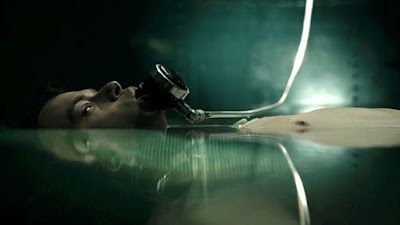In A Cure For Wellness newly appointed business executive Lockhart is discovered for falsifying business deals and left with two options: stay and face the possibility of prison or journey to the Swiss Alps and retrieve the financial firm's CEO from the Volmer Institute, a mysterious wellness center specializing in hydrotherapy. Once Lockhart arrives at the institute and fails to convince Pembroke to return, he tries to leave and ends up in a car accident. Lockhart then is admitted as a patient within the clinic only to discover suspicious ongoings at every turn.
A Cure For Wellness is an original oddity, a quirky film I must commend for trying to be different but found rather repulsive the longer I watched. Gore Verbinski directs and manages to successfully invoke an unnatural undertone well throughout the two and a half hour runtime. Verbinski and cinematographer Bojan Bazelli craft haunting imagery while Eve Stewart's production design evokes an eerie Euro-vibe, it's both old-fashioned and pristine yet the background environment leads you to feel a gnawing sense of unease.
It's odd but A Cure For Wellness' visual aesthetic lends more to the supernatural sense of things as opposed to it's auditory elements. I normally don't highlight an uninspired score, but Benjamin Wallfisch's compositions essentially encompassed one theme repetitively interspersed over and over again. It was absolutely maddening how many times I heard the same theme over two hours and thirty minutes.
However, there is one interesting aspect of A Cure For Wellness; Verbinski delivers on the title's promise. You will certainly not feel well after two and a half hours of this revolting mess. Verbinski keeps the camera rolling just when you want it to stop, leading to a few moments so alarming I was forced to close my eyes (I'm not typically squeamish). When you aren't nauseated, you may find yourself bored as Verbinski allows this story to overstay its welcome.
The script results from a story coughed up by Verbinski and Justin Haythe, with Haythe penning the actual screenplay. Haythe and Verbinski have a lot of room to play around in this niche world but are overambitious as they spread their focus so wide that they can't inject enough complexity or intruige to interest viewers for long. The duo consistently pose tantalizing mysteries but the answers aren't delivered till near the film's conclusion and are either morbidly peculiar or fairly predictable. The screenplay also doesn't have a full grasp of its characters as Lockhart's motivations and actions are ever-shifting, contrast to what you're lead to believe the character's fundamentals are.
On top of that, Lockhart's an unlikable protagonist and so you're not quite invested in him as a character. Dane Dahaan brings a cold, calculated demeanor to Lockhart that doesn't really aid this problem. Dahaan does fine with what he's given but is never really given the chance to showcase any relatable qualities, making it even more difficult to connect to the character. He's really just there to discover the shock and awe of everything going on at the institute and for that purpose I guess he succeeds but I wish they hadn't wasted an actor of Dehaan's talents like that.
Mia Goth plays the most puzzling character Hannah, dually expressing innocence and abnormality all while putting forth an enigmatic front. Jason Isaacs all the while thrusts himself forward as the cryptic physcian Volmer. Outside those core three performances there isn't much left for the two-dimensional stock characters in A Cure For Wellness leaving a mixed ensemble.
If you're interested in bizarre horror, then A Cure For Wellness might be for you and I can attest that there are exceptional technical elements at play here. Otherwise, I was dissatisfied overall. A Cure For Wellness is easily one of the most disturbing cinematic experiences I've ever had and on account of that I can't advise you waste time or money on this sickening story.












0 Yorumlar